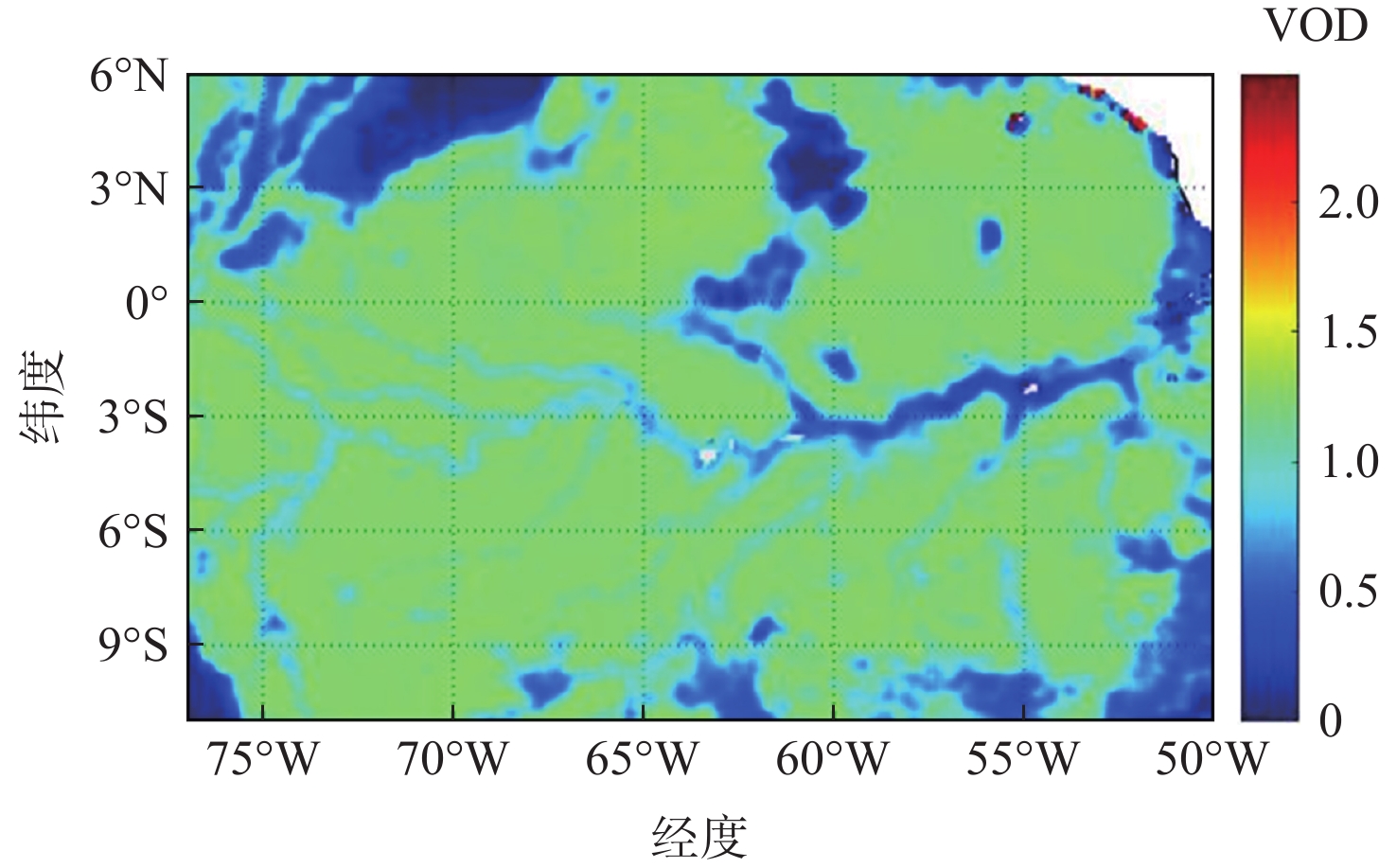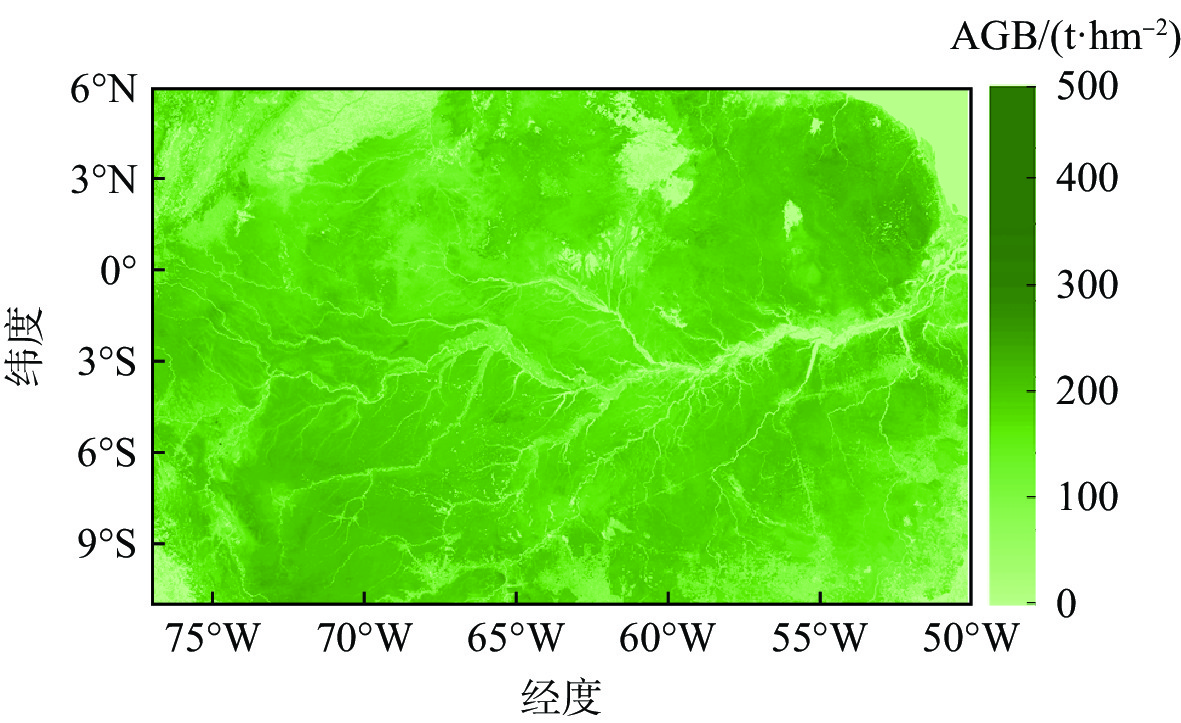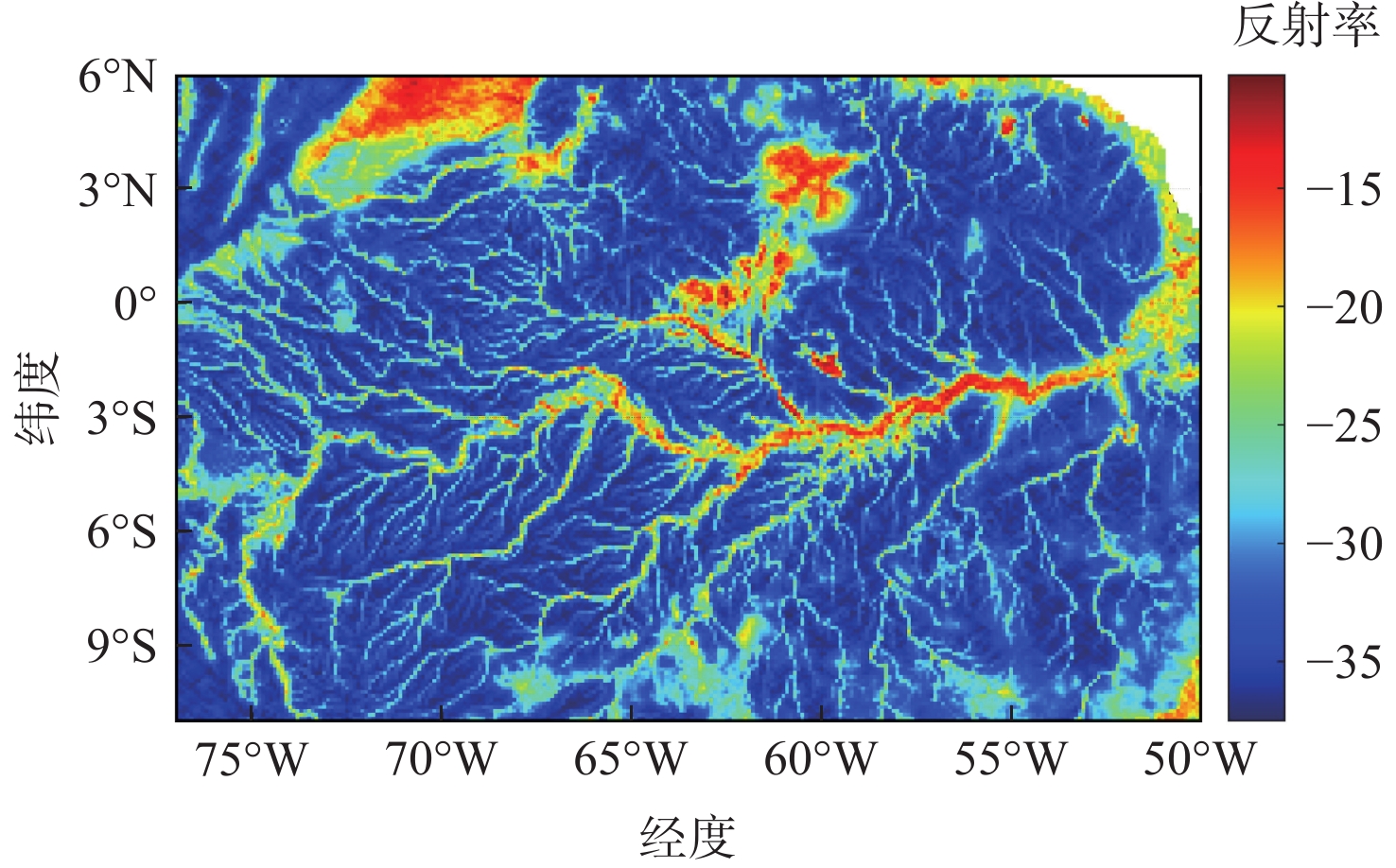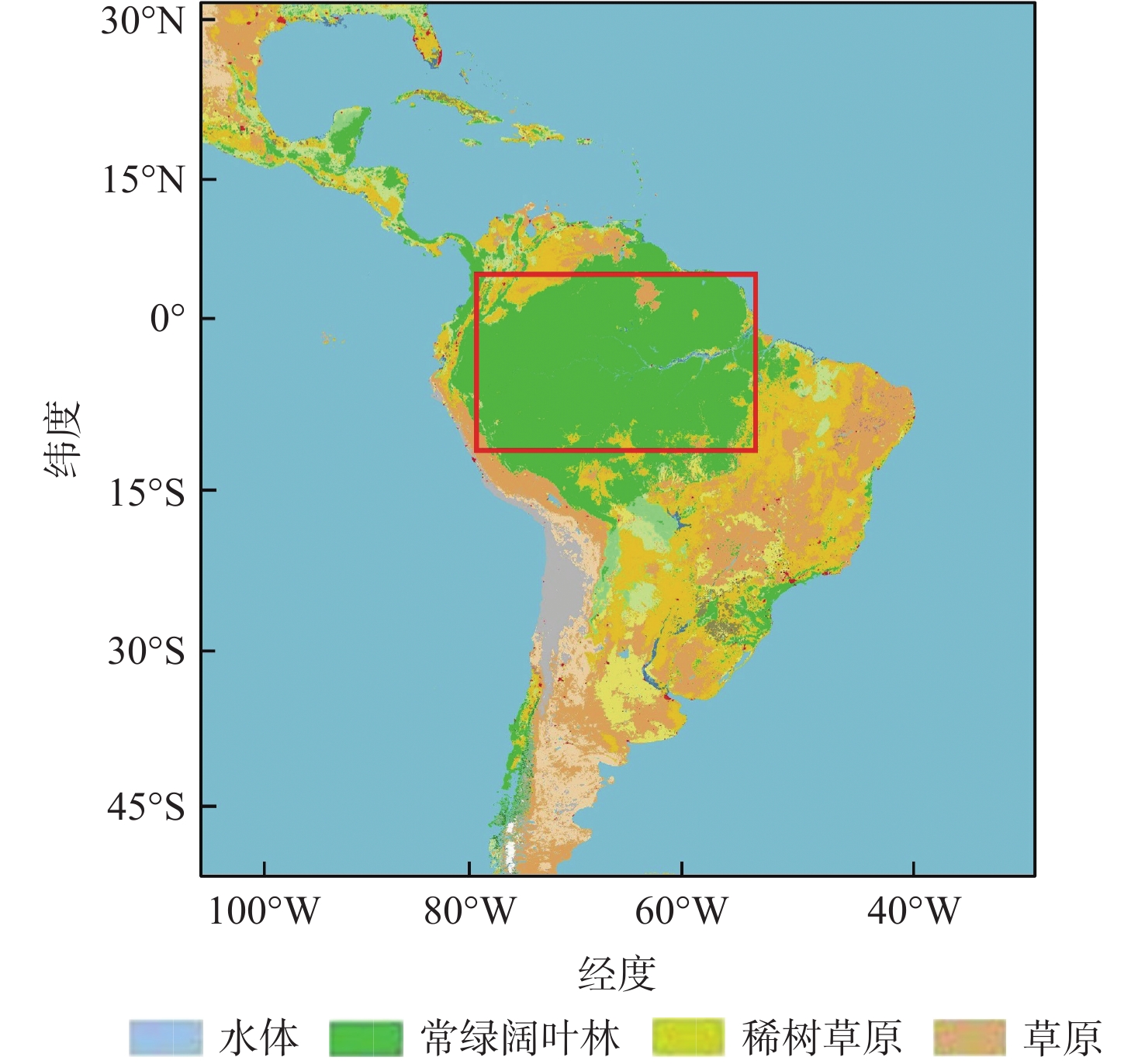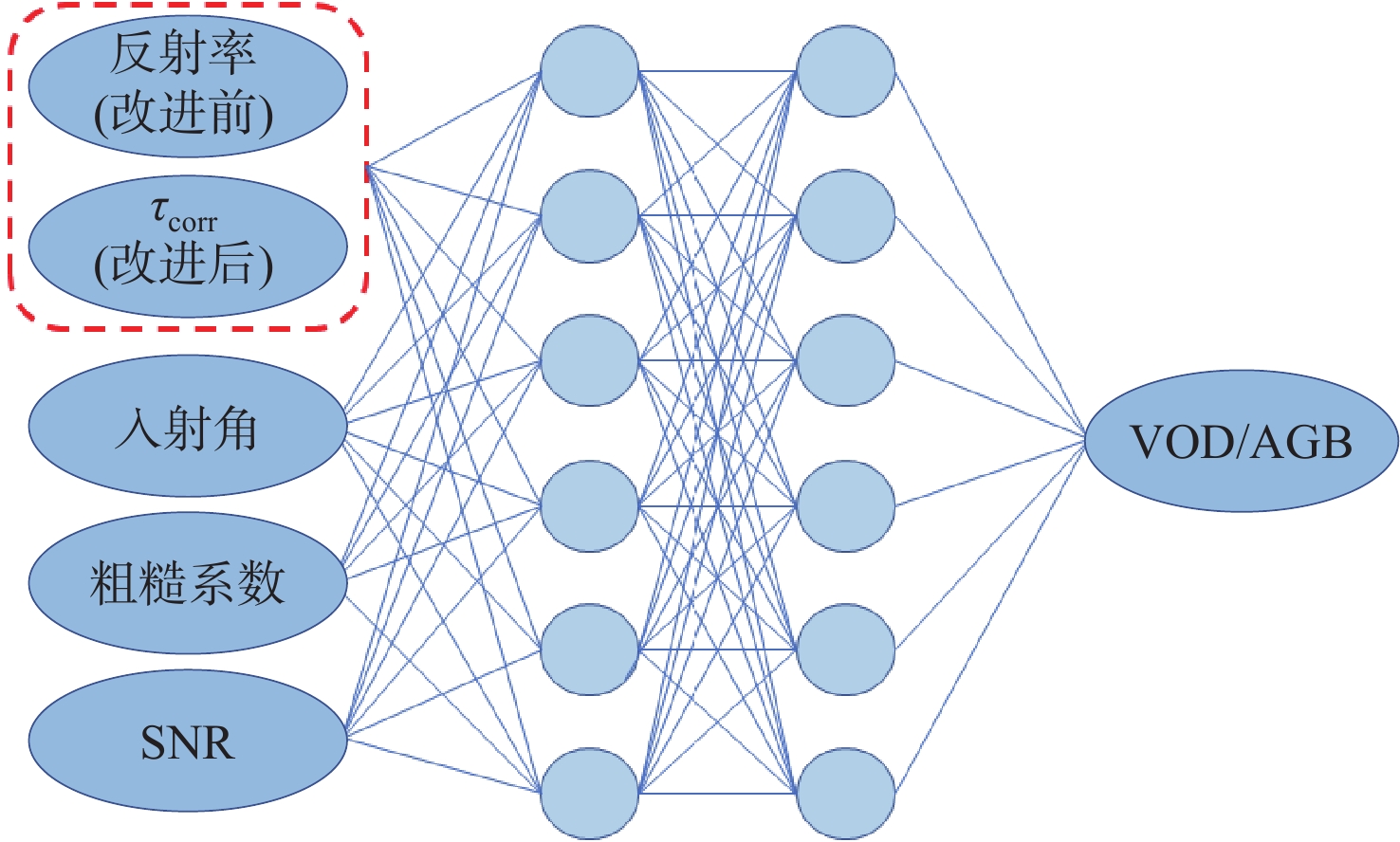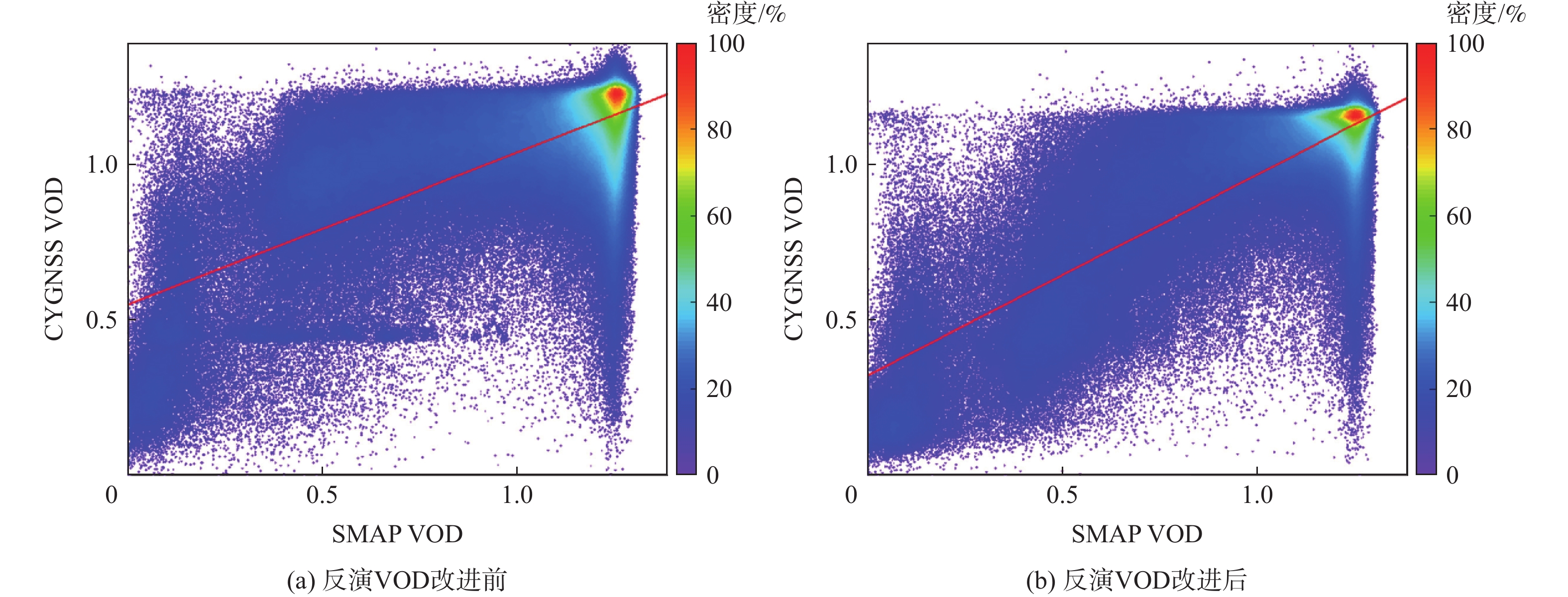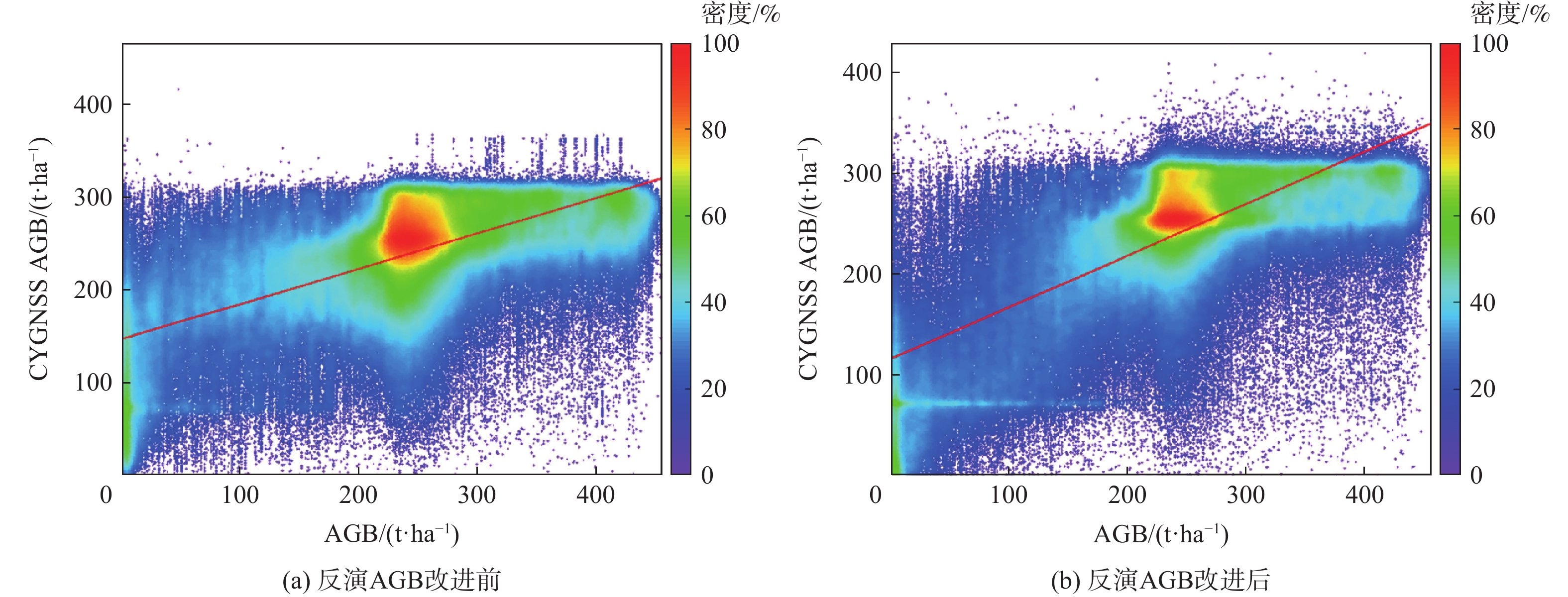-
摘要:
基于Tau-Omega模型提出一种涉及地面土壤湿度修正的星载全球导航卫星系统反射测量(GNSS-R)森林地上生物量反演方法。选择SMAP卫星的土壤湿度作为辅助数据,运用Tau-Omega模型对旋风卫星导航系统(CYGNSS)反射率做出改正,提高建模参数的准确性。将SMAP卫星提供的植被光学深度(VOD)和地上植被生物量(AGB)地图作为生物量参考数据,比较了改正前后观测值与参考数据的相关性变化。结果表明,改正后相关系数提升明显,改正后参数较反射率与VOD的相关系数从0.54提升到了0.67,与AGB的相关系数从0.46提升到了0.56。随后通过人工神经网络分别基于改正后的参数和反射率建立GNSS-R VOD和AGB反演模型。结果表明,所提方法能够有效提高VOD和AGB的反演精度,且在生物量水平较低的地区改进效果更优。对于VOD反演,改进后相关系数从0.70提升到了0.83,RMES从0.21降低到了0.17;对于AGB反演,改进后相关系数从0.61提升到了0.71,RMES从74 t/hm2 降低到了65 t/hm2 。
Abstract:Based on the Tau-Omega model, a spaceborne global navigation satellite system relectometry (GNSS-R) forest aboveground biomass inversion method considering the correction of ground soil moisture is proposed. The cyclone global navigation satellite system (CYGNSS) reflectance was corrected using the Tau-Omega model to increase the modeling parameters' accuracy, and SMAP satellite soil moisture was chosen as supplementary data. The biomass reference data utilized was the vegetation optical depth (VOD) supplied by SMAP satellite and the above-ground biomass (AGB) maps. The correlation changes between the observed values and the reference data prior to and following improvement were compared. The results show that the correlation coefficient increases significantly after the correction. The correlation coefficient between the parameters after improvement with VOD is increased from 0.54 to 0.67 compared to the reflectivity with VOD, and the correlation coefficient with AGB is increased from 0.46 to 0.56. Then, the GNSS-R VOD and AGB inversion models were established based on the corrected parameters and reflectivity through the artificial neural network, respectively. The results show that the improved method can effectively improve the inversion accuracy of VOD and AGB, and the improvement effect is better in areas with low biomass levels. For VOD inversion, after improvement, the correlation coefficient increased from 0.70 to 0.83, and the RMES decreased from 0.21 to 0.17; for AGB inversion, after improvement, the correlation coefficient increased from 0.61 to 0.71, and the RMES decreased from 74 t/hm2 to 65 t/hm2.
-
Key words:
- CYGNSS /
- GNSS-R /
- forest biomass /
- SMAP satellite /
- soil moisture /
- vegetation optical depth
-
表 1 不同植被类型单次散射反照率
Table 1. Single scattering albedo corresponding to different vegetation types
植被类型 常绿针叶林、常绿阔叶林 0.07 落叶针叶林、落叶阔叶林 0.07 混交林 0.07 封闭的灌木地、开放的灌木地 0.05 多树草原 0.05 稀树草原 0.08 草原 0.05 表 2 不同入射角下的相关系数
Table 2. Correlation coefficients at different incident angles
角度/(°) 反射率与VOD 反射率与AGB [0~10] −0.53 −0.46 [10~20] −0.53 −0.46 [20~30] −0.52 −0.45 [30~40] −0.53 −0.47 [40~50] −0.57 −0.49 [50~60] −0.58 −0.49 [60~70] −0.56 −0.46 [70~80] −0.37 −0.28 表 3 改进前后相关系数
Table 3. Correlation coefficients before and after improvement
参考数据 反射率 VOD −0.54 0.51 0.67 AGB −0.46 0.42 0.56 表 4 相关系数和RMSE
Table 4. Correlation coefficient and RMSE
参考数据 相关系数 RMSE VOD AGB/(t·hm−2) VOD AGB/(t·hm−2) 改进前 0.70 0.61 0.21 74 改进后 0.83 0.71 0.17 65 -
[1] 范文义, 张海玉, 于颖, 等. 三种森林生物量估测模型的比较分析[J]. 植物生态学报, 2011, 35(4): 402-410. doi: 10.3724/SP.J.1258.2011.00402FAN W Y, ZHANG H Y, YU Y, et al. Comparison of three models of forest biomass estimation[J]. Chinese Journal of Plant Ecology, 2011, 35(4): 402-410(in Chinese). doi: 10.3724/SP.J.1258.2011.00402 [2] KELLER M. Revised method for forest canopy height estimation from geoscience laser altimeter system waveforms[J]. Journal of Applied Remote Sensing, 2007, 1(1): 013537. doi: 10.1117/1.2795724 [3] CHAVE J, ANDALO C, BROWN S, et al. Tree allometry and improved estimation of carbon stocks and balance in tropical forests[J]. Oecologia, 2005, 145(1): 87-99. doi: 10.1007/s00442-005-0100-x [4] CARRENO-LUENGO H, LUZI G, CROSETTO M. Above-ground biomass retrieval over tropical forests: A novel GNSS-R approach with CyGNSS[J]. Remote Sensing, 2020, 12(9): 1368. doi: 10.3390/rs12091368 [5] BAGHDADI N, LE MAIRE G, BAILLY J S, et al. Evaluation of ALOS/PALSAR L-band data for the estimation of eucalyptus plantations aboveground biomass in Brazil[J]. IEEE Journal of Selected Topics in Applied Earth Observations and Remote Sensing, 2015, 8(8): 3802-3811. doi: 10.1109/JSTARS.2014.2353661 [6] LE TOAN T, QUEGAN S, DAVIDSON M W J, et al. The BIOMASS mission: Mapping global forest biomass to better understand the terrestrial carbon cycle[J]. Remote Sensing of Environment, 2011, 115(11): 2850-2860. doi: 10.1016/j.rse.2011.03.020 [7] GONÇALVES F, TREUHAFT R, LAW B, et al. Estimating aboveground biomass in tropical forests: Field methods and error analysis for the calibration of remote sensing observations[J]. Remote Sensing, 2017, 9(1): 47. doi: 10.3390/rs9010047 [8] WU X R, GUO P, SUN Y Q, et al. Recent progress on vegetation remote sensing using spaceborne GNSS-reflectometry[J]. Remote Sensing, 2021, 13(21): 4244. doi: 10.3390/rs13214244 [9] ULABY F T. Microwave remote sensing, active and passive[J]. Microwave Remote Sensing Fundamentals and Radiometry, 1981, 1: 191-208. [10] 吴学睿, 李颖, 李传龙. 基于Bi-Mimics模型的GNSS-R农作物生物量监测理论研究[J]. 遥感技术与应用, 2012, 27(2): 220-230.WU X R, LI Y, LI C L. Research on crop biomass monitoring using GNSS-R technique based on Bi-Mimics model[J]. Remote Sensing Technology and Application, 2012, 27(2): 220-230(in Chinese). [11] CHEW C, SHAH R, ZUFFADA C, et al. Demonstrating soil moisture remote sensing with observations from the UK TechDemoSat-1 satellite mission[J]. Geophysical Research Letters, 2016, 43(7): 3317-3324. doi: 10.1002/2016GL068189 [12] CAMPS A, PARK H, PABLOS M, et al. Sensitivity of GNSS-R spaceborne observations to soil moisture and vegetation[J]. IEEE Journal of Selected Topics in Applied Earth Observations and Remote Sensing, 2016, 9(10): 4730-4742. doi: 10.1109/JSTARS.2016.2588467 [13] CARRENO-LUENGO H, LOWE S T, ZUFFADA C, et al. Spaceborne GNSS-R from the SMAP mission: First assessment of polarimetric scatterometry[C]//Proceedings of the IEEE International Geoscience and Remote Sensing Symposium. Piscataway: IEEE Press, 2017: 4095-4098. [14] WAN W, JI R, LIU B J, et al. A two-step method to calibrate CYGNSS-derived land surface reflectivity for accurate soil moisture estimations[J]. IEEE Geoscience and Remote Sensing Letters, 2020, 19: 2500405. [15] SANTI E, PALOSCIA S, PETTINATO S, et al. Remote sensing of forest biomass using GNSS reflectometry[J]. IEEE Journal of Selected Topics in Applied Earth Observations and Remote Sensing, 2993, 13: 2351-2368. [16] SANTI E, CLARIZIA M P, COMITE D, et al. Detecting fire disturbances in forests by using GNSS reflectometry and machine learning: A case study in Angola[J]. Remote Sensing of Environment, 2022, 270: 112878. doi: 10.1016/j.rse.2021.112878 [17] ZHAN Q, VALL-LLOSSERA M, PABLOS M, et al. Improving the rice yield estimation using SMOS and CYGNSS GNSS-R data[C]//Proceedings of the IEEE International Geoscience and Remote Sensing Symposium. Piscataway: IEEE Press, 2020: 5254-5257. [18] KERR Y H, WALDTEUFEL P, RICHAUME P, et al. The SMOS soil moisture retrieval algorithm[J]. IEEE Transactions on Geoscience and Remote Sensing, 2012, 50(5): 1384-1403. doi: 10.1109/TGRS.2012.2184548 [19] O’NEILL P, BINDLISH R, CHAN S, et al. Algorithm theoretical basis document level 2 & 3 soil moisture (passive) data products[EB/OL]. (2021-10-12)[2022-04-13]. [20] DONG Z N, JIN S G. Evaluation of the land GNSS-reflected DDM coherence on soil moisture estimation from CYGNSS data[J]. Remote Sensing, 2021, 13(4): 570. doi: 10.3390/rs13040570 [21] O'NEILL P, CHAN S, NJOKU E, et al. SMAP enhanced L3 radiometer global and polar grid daily 9 km EASE-Grid soil moisture, Version 5[EB/OL]. Boulder: NASA National Snow and Ice Data Center Distributed Active Archive Center, 2021(2021-10-12)[2022-04-13]. https://doi.org/10.5067/4DQ54OUIJ9DL. [22] AVITABILE V, HEROLD M, HEUVELINK G B M, et al. An integrated pan-tropical biomass map using multiple reference datasets[J]. Global Change Biology, 2016, 22(4): 1406-1420. doi: 10.1111/gcb.13139 [23] SAATCHI S S, HARRIS N L, BROWN S, et al. Benchmark map of forest carbon stocks in tropical regions across three continents[J]. Proceedings of the National Academy of Sciences of the United States of America, 2011, 108(24): 9899-9904. [24] BACCINI A, GOETZ S J, WALKER W S, et al. Estimated carbon dioxide emissions from tropical deforestation improved by carbon-density maps[J]. Nature Climate Change, 2012, 2: 182-185. doi: 10.1038/nclimate1354 [25] JENSEN K, MCDONALD K, PODEST E, et al. Assessing L-band GNSS-reflectometry and imaging radar for detecting sub-canopy inundation dynamics in a tropical wetlands complex[J]. Remote Sensing, 2018, 10(9): 1431. doi: 10.3390/rs10091431 [26] YUEH S H, SHAH R, CHAUBELL M J, et al. A semiempirical modeling of soil moisture, vegetation, and surface roughness impact on CYGNSS reflectometry data[J]. IEEE Transactions on Geoscience and Remote Sensing, 2020, 60: 5800117. -







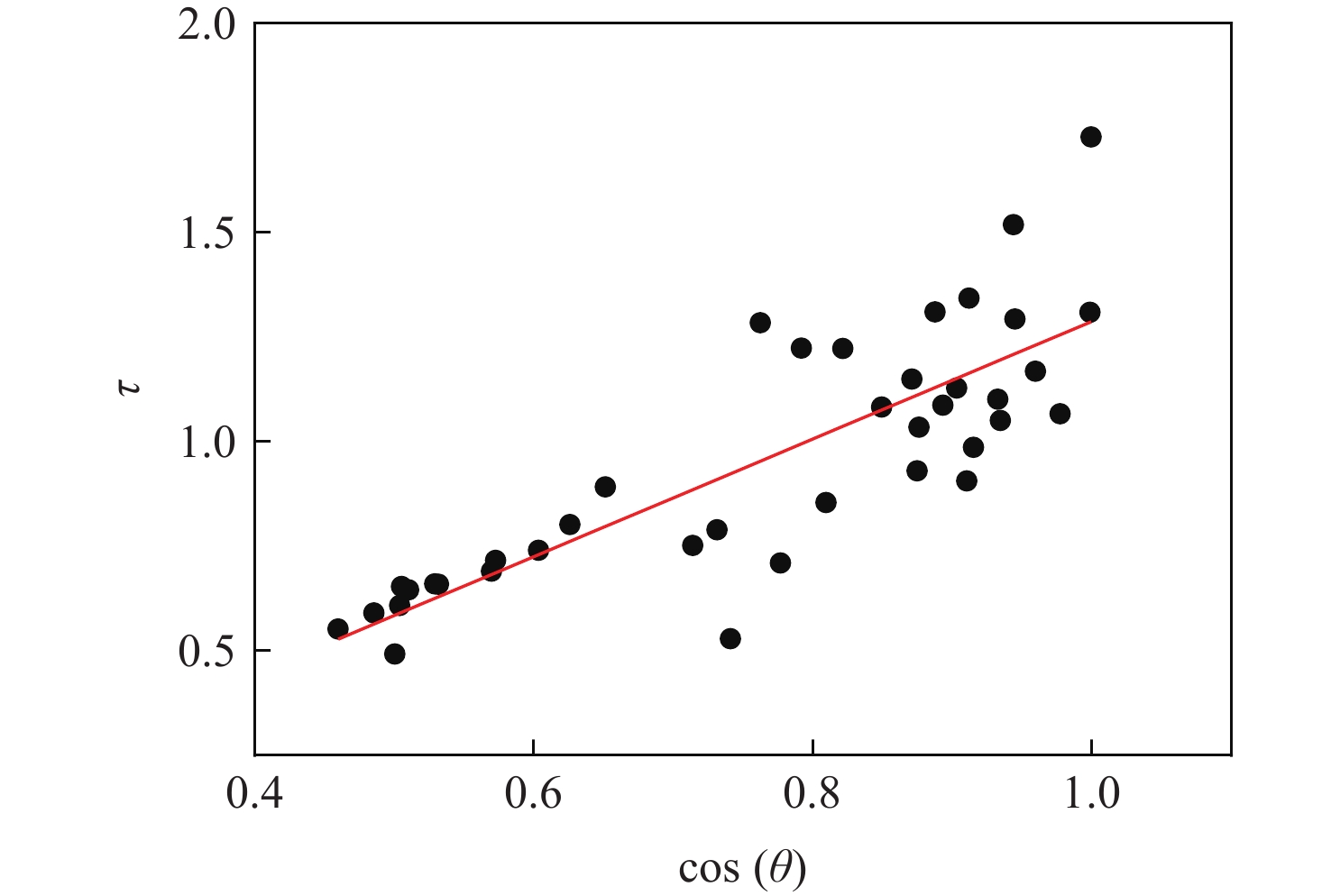
 下载:
下载:
